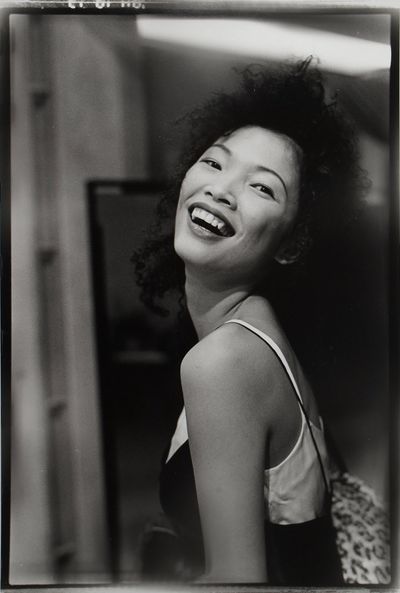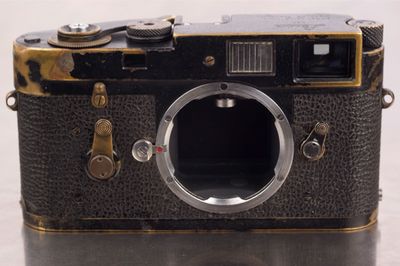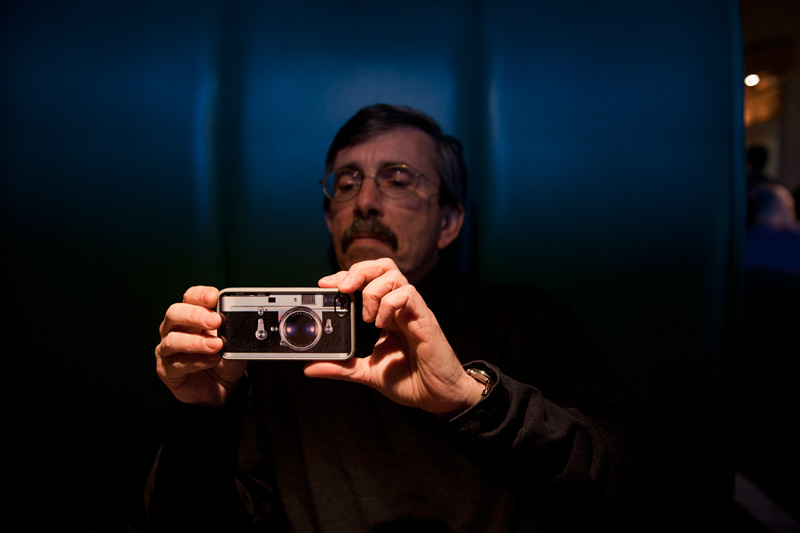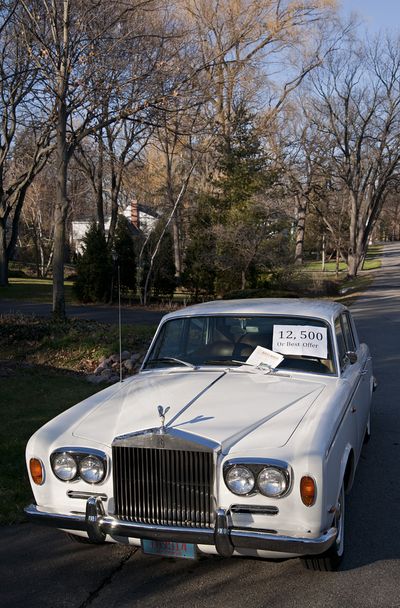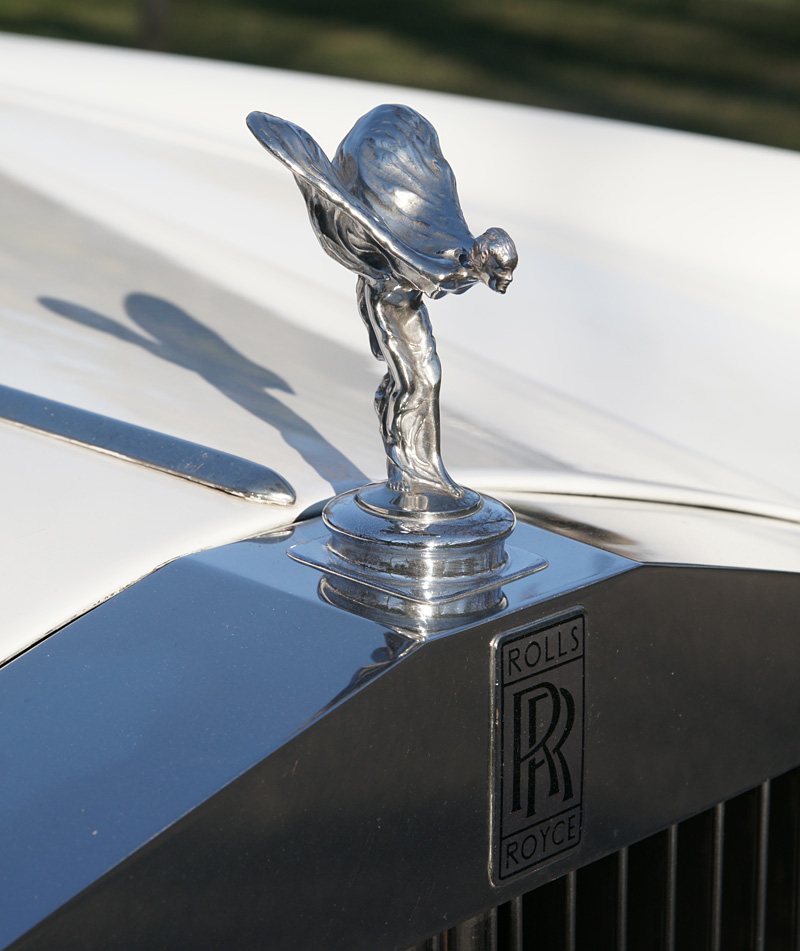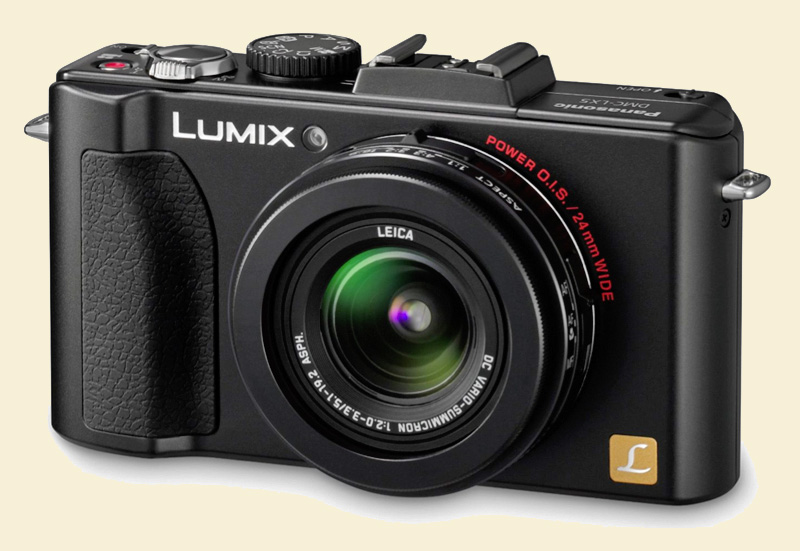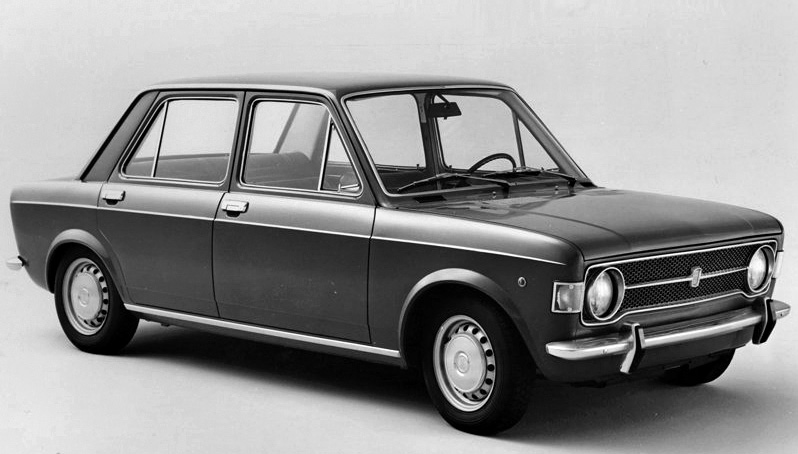Shooting with a Fuji X100
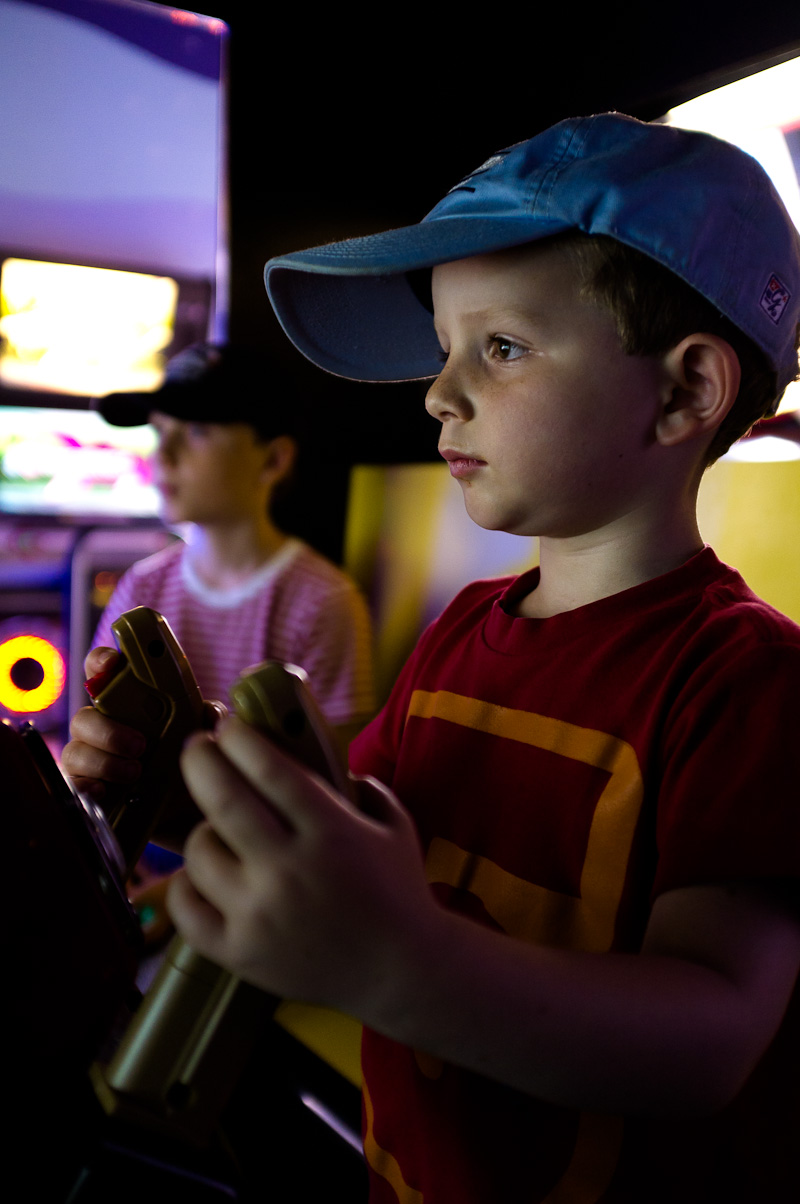 ISO 2000, ƒ/2 at 1/60th. This is portrait bokeh with a 23mm ƒ/2 lens.
ISO 2000, ƒ/2 at 1/60th. This is portrait bokeh with a 23mm ƒ/2 lens.
By Robert Plotkin
When the Fuji X100 was announced at Photokina 2010, the trade show held in Germany, it was as if a supermodel walked into a Japanese lederhosen convention. Mouths gaped, the band’s instruments clattered to the floor, and hands collectively grasped at the Fuji’s shiny dials.
was announced at Photokina 2010, the trade show held in Germany, it was as if a supermodel walked into a Japanese lederhosen convention. Mouths gaped, the band’s instruments clattered to the floor, and hands collectively grasped at the Fuji’s shiny dials.
Our dates jabbed us in the ribs and we looked down at their cheap, black plastic and for the first time saw the piratical eyepatches covering the disfigurement of their missing viewfinders. We looked at them and said: where is your magnesium chassis, your knurled aperture and shutter rings, your gazonga sensor? You have let yourself go, happy in your K-Mart sweats, opiating me with cotton candy settings and cheap, slow glass.
You’ve made me lazy. I’m not the photographer I used to be, the dashing, crouching, hanging, contorting, backward-running man of my youth. Now I zoom in and out, flatten the light with pop-up flash, my depth-of-field neither narrow nor wide, my photographs as indistinct as a beige Camry.
We look back at our idealized selves holding Olympus OM-1's, Canon F-1's and Nikon F2's, manually follow-focusing fast, prime lenses. That’s what we need: a small, high quality camera with manual controls and a 35mm-equivalent ƒ/2 lens. When the Fuji walked into the room it was like our college girlfriends had time-machined into a Ferrari 358 Spyder, pulled up alongside us on the freeway, flashed us a smile and asked us to open the sliding doors of our minivans and leap.
I leapt in May and fell asleep cradling the Fuji. The next morning she refused to wake. I was worried that she was dead, until a mechanical whirling began, like someone pulling the sheets over their head and turning over. Then it began clicking at me like a Xhosa princess demanding a quad espresso. It finally lit its optical viewfinder 2.3 seconds after I first turned her on. The viewfinder was so magnificent that I temporarily forgot her morning breath.
I peered through the Fuji’s viewfinder with the same expression as a voyeur approaching a keyhole. Few of us are willing to carry around an SLR. So for the last eight years we have been forced to experience much of the best of life through a flickering electronic viewing screen or EVF, like a torture victim seated in a dark room, eyes pried open watching a badly scratched reel of experimental film.
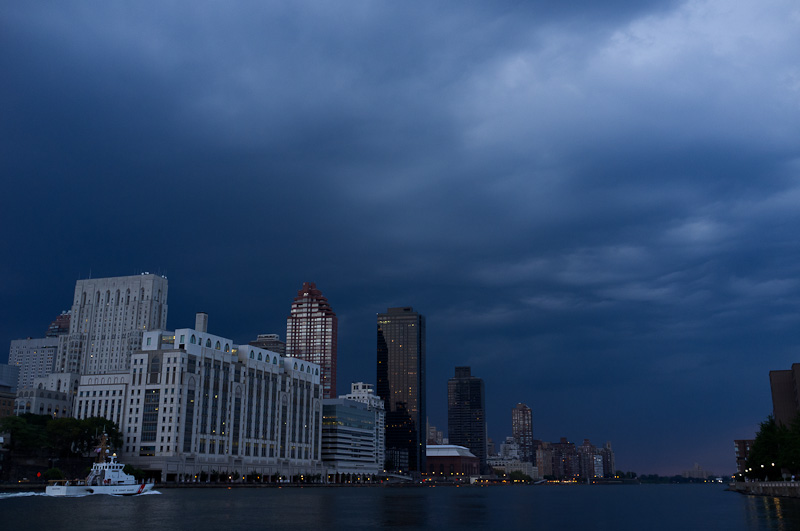 My son Max took this photo of the East River at ISO 1000, ƒ/4 at 1/200th.
My son Max took this photo of the East River at ISO 1000, ƒ/4 at 1/200th.
Well, now we are liberated, and free to stabilize the X100 against our face and mediate the world through a clear hunk of glass–most of the time. For the viewfinder suffers from a multiple personality disorder that Fuji kindly refers to as "hybrid." With the flick of a switch on the front of the camera a blinder covers the viewfinder and it alters into a conventional electronic viewfinder.
The electrical viewfinder is necessary because the optical focusing is imprecise. The huge focus patch makes it impossible to tell if it will focus on the nose or the pupil during portraits. In essence, Fuji has scored a PR coup in characterizing the hybrid viewfinder as a boon. It is a crutch for wobbly optical focusing. The X100 would be well served by incorporating Olympus's pupil focusing or offering parallax corrected spot focusing.
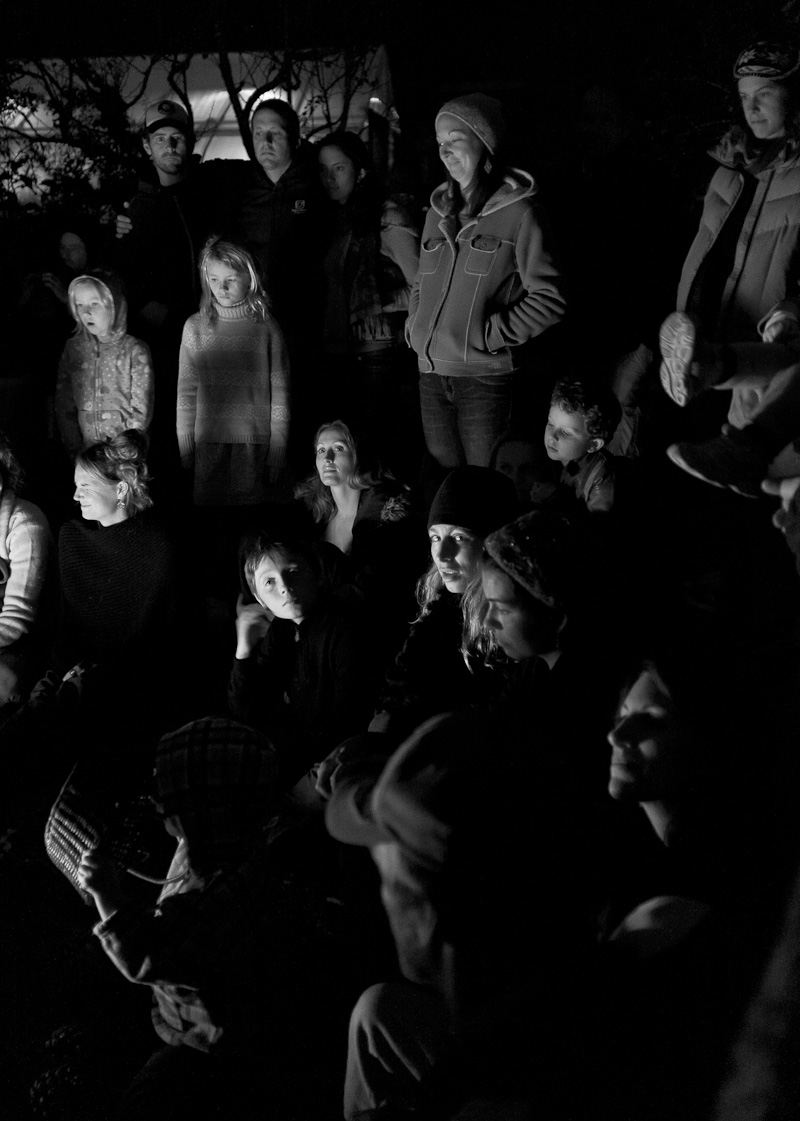 ISO 200, ƒ/2 at 1/20th.
ISO 200, ƒ/2 at 1/20th.
The imprecise focusing takes an unusually long time. It is like waiting for a cashier to incorrectly manipulate an abacus and hand you the wrong change. So most of the time I keep the camera in manual focus mode and use the AEL button on the back to lock focus on the subject.
The shutter fires with a dainty click. Some prefer the quietude but I find it out of character with the mechanical ethos of the camera. It sounds like a compact camera, and lacks the machine-gun recoil of the Micro 4/3 motor-drive sounds. In fact, it really doesn’t have a motor drive. If you hold down the shutter button it fires one shot and you have to wait about second before it will fire again. In order to shoot a burst, you have to go through a cumbersome procedure: press the flimsy disk on the back toward drive, click it from single to continuous, choose three or five per second and then hold down the shutter until the 8-shot RAW buffer fills. Once it fills, you have to wait about 14 seconds until you can shoot again. Very often, a decisive moment taunts you during this interregnum and flits away un-captured.
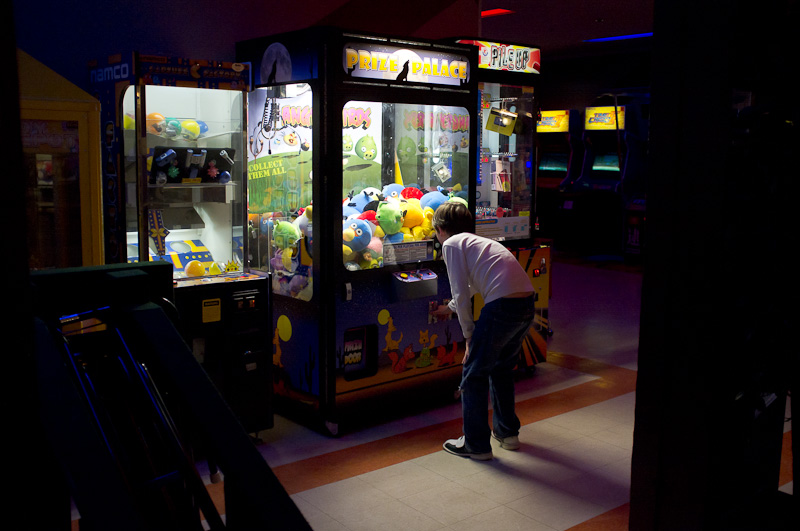 ISO 3200, ƒ/2 at 1/1000th, since I was shooting action at a bowling alley. The X100 has excellent automatic white balance.
ISO 3200, ƒ/2 at 1/1000th, since I was shooting action at a bowling alley. The X100 has excellent automatic white balance.
So one must ask—why not shoot with a fast-focusing Micro 4/3 camera instead? The answer lies below in the photograph of my son Otto jumping on the bed. I did have to manually lock the focus and then consumerishly button-press it into continuous mode. I missed many potential shots waiting for the buffer to clear. But I got the shot, and the ISO 3200 results are clean, luminous and detailed, with deep, rich color that converts into unusually good black-and-white tonality. There is nothing like a big sensor married to a sharp, prime lens. The image quality is a magnitude better than Micro 4/3 sensors and on par with all but full-frame cameras.
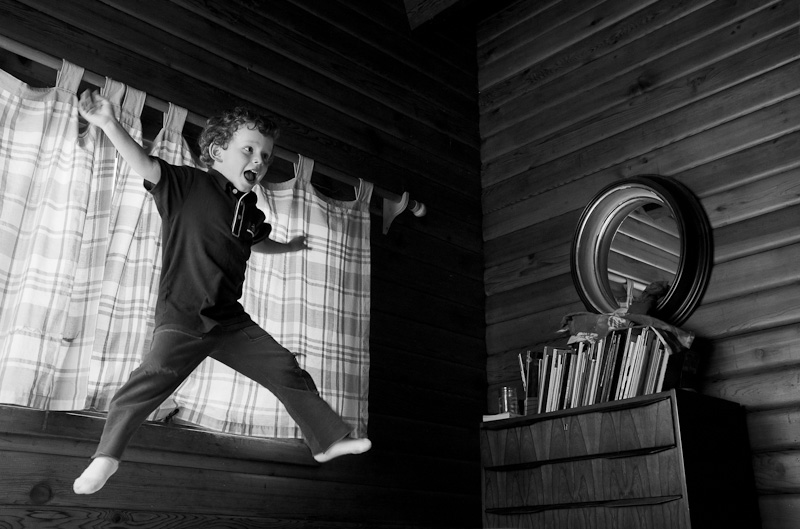 3200 ISO, ƒ/5.6 at 1/125 using 5-fps continuous mode. All photos have been adjusted in Lightroom 3.
3200 ISO, ƒ/5.6 at 1/125 using 5-fps continuous mode. All photos have been adjusted in Lightroom 3.
Fuji makes the H system lenses for Hasselblad, which are used by the most demanding commercial photographers in the world. The X100 is not as sharp as a Leica Summicron wide open, but stop it down to ƒ/2.8 and it crystalizes. One must remember that the lens has the field of view of a 35mm lens but the depth of field of a 23mm lens. Shot open and close, the background is pleasantly de-emphasized but not bokehlicious.
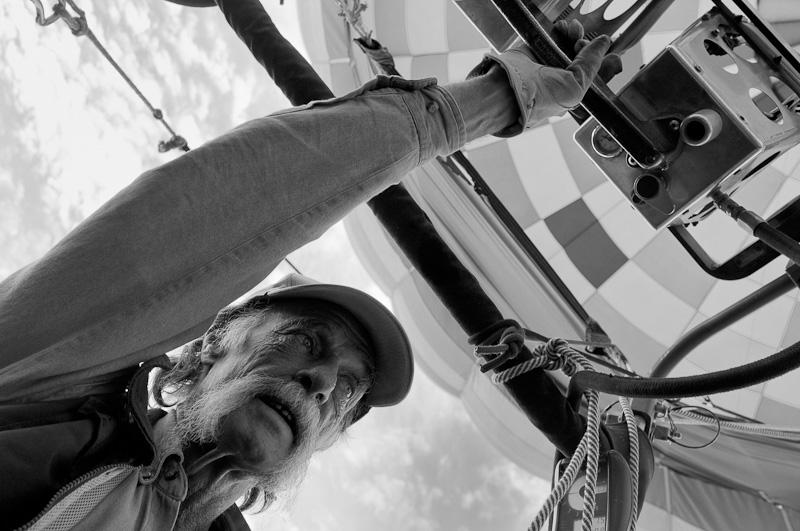 Ballooning shot at ISO 400, ƒ/4 at 1/250th. The Fuji has a wide dynamic range as illustrated by the highlighted clouds and shadowed face.
Ballooning shot at ISO 400, ƒ/4 at 1/250th. The Fuji has a wide dynamic range as illustrated by the highlighted clouds and shadowed face.
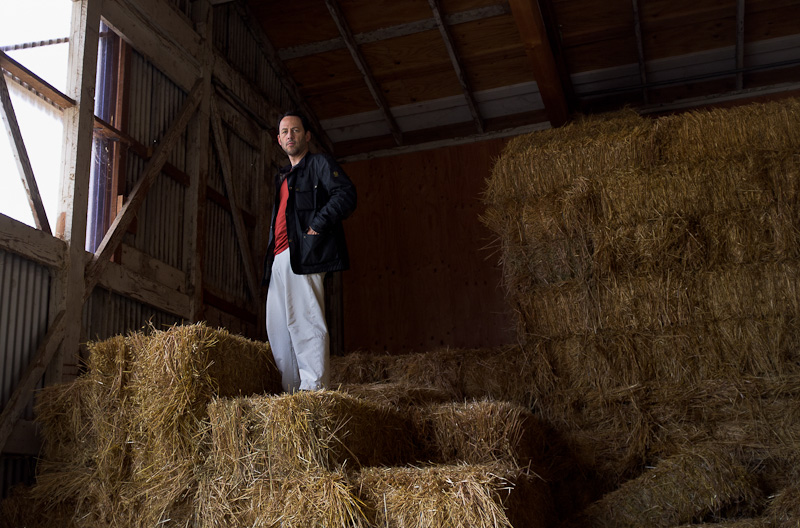 Five-year-old Otto took this portrait of me at ISO 500, ƒ/5.6 at 1/500th. The smooth transition from highlight to shadow is lacking in smaller sensors.
Five-year-old Otto took this portrait of me at ISO 500, ƒ/5.6 at 1/500th. The smooth transition from highlight to shadow is lacking in smaller sensors.
Until recently, the compact, large sensor, fixed-lens cameras were maddeningly slow. The Sigma DP1 and Leica X1 produced exceptional image quality but after about 15 minutes I wanted to grab them by the strap, swing them over my head, and smash them to bits. The Fuji X100 straddles the threshold of usability. Some people will be taken with her platonic form, optical viewfinder, and fat pixels. Others will resent Beta-testing the slow autofocus, cheap control wheel, and dyslexic menu.
Shooting the Fuji X100 is like driving a vintage Ferrari: bugs in your teeth, pebbles ricocheting off your goggles, double-clutching straight cut gears, applying opposite lock to correct a slide—and coming out of the corner neck-and-neck with a soccer mom in a black Escalade of an SLR. The X100 invites conversation about your good taste and photographic acumen. You can spend vacant moments staring at its lens hood, turning its aperture ring, and chimping the sharp, richly colorful, smooth-toned images.
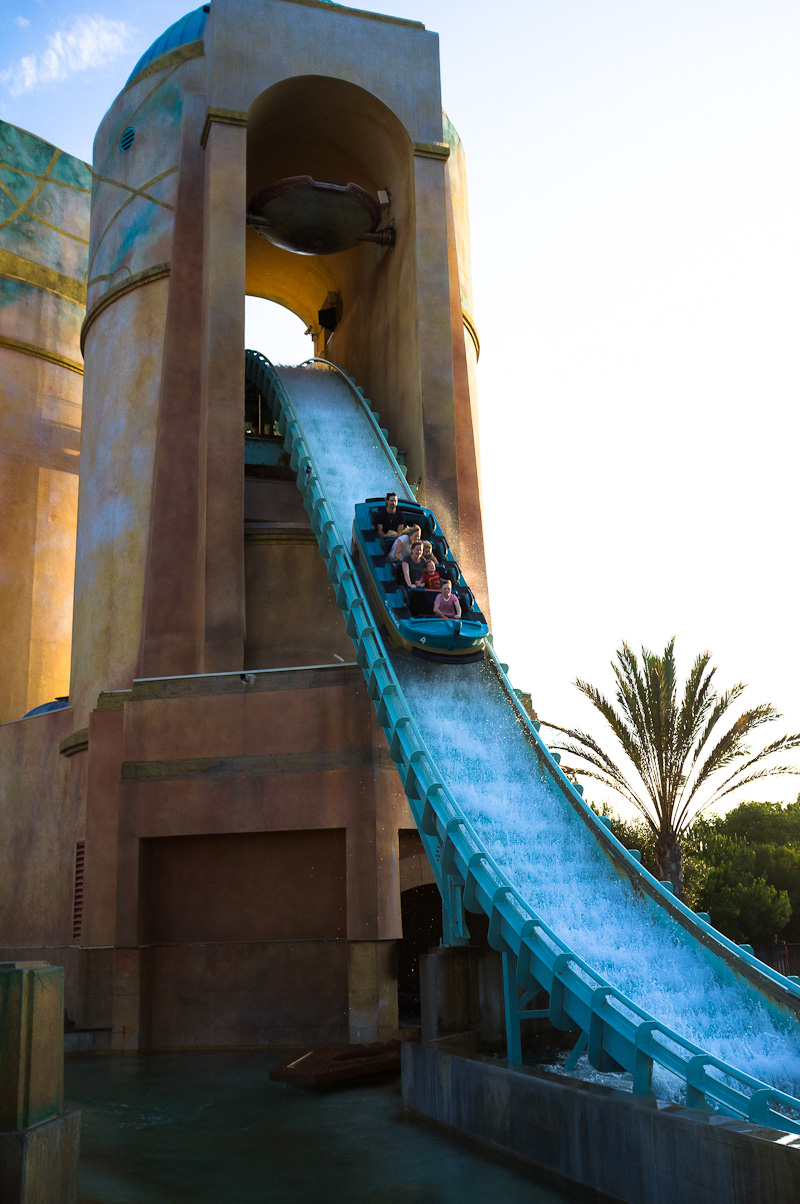 ISO 1000, ƒ/5 at 1/2000th. The X100 again shows a rich color palette and excellent transition from highlight to shadow.
ISO 1000, ƒ/5 at 1/2000th. The X100 again shows a rich color palette and excellent transition from highlight to shadow.
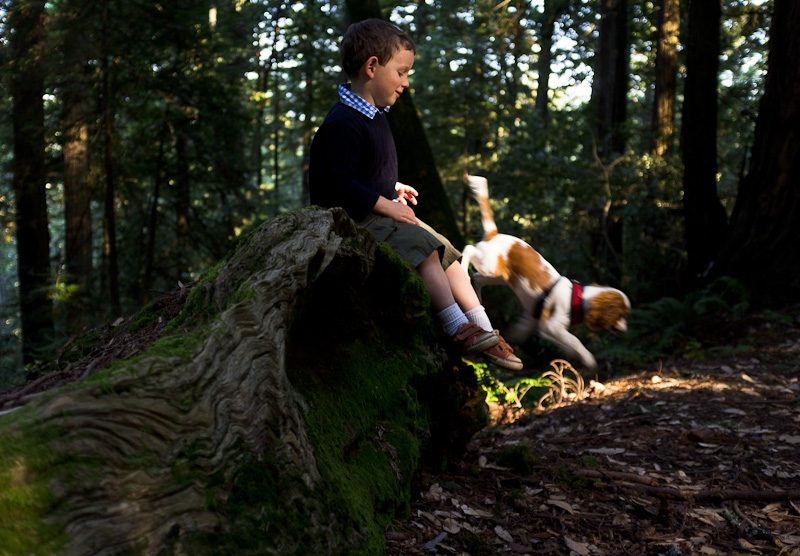 ISO 400, ƒ/5.6 at 1/125th. The X100 held the highlights in the dog fur yet was able to retain detail in hollow of the felled tree.
ISO 400, ƒ/5.6 at 1/125th. The X100 held the highlights in the dog fur yet was able to retain detail in hollow of the felled tree.
 Action shots require locking focus and exposure and waiting.
Action shots require locking focus and exposure and waiting.
ISO 800, ƒ/8 at 1/1000th.
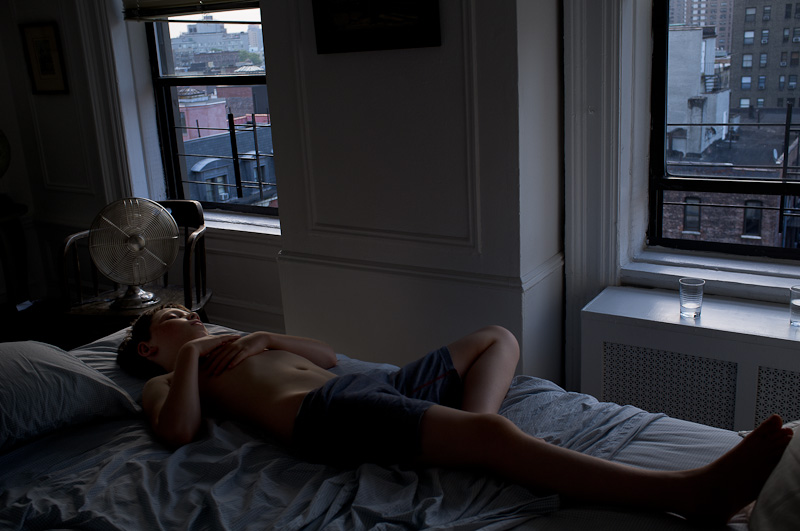 Sweaty dawn. ISO 200, ƒ/4 at 1/30th.
Sweaty dawn. ISO 200, ƒ/4 at 1/30th.
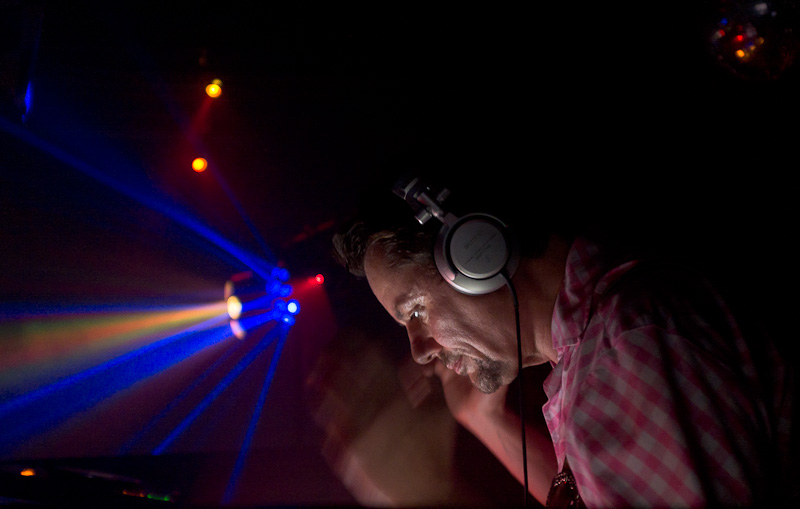 DJ shot ISO 1600, ƒ/2 at 1/60th.
DJ shot ISO 1600, ƒ/2 at 1/60th.
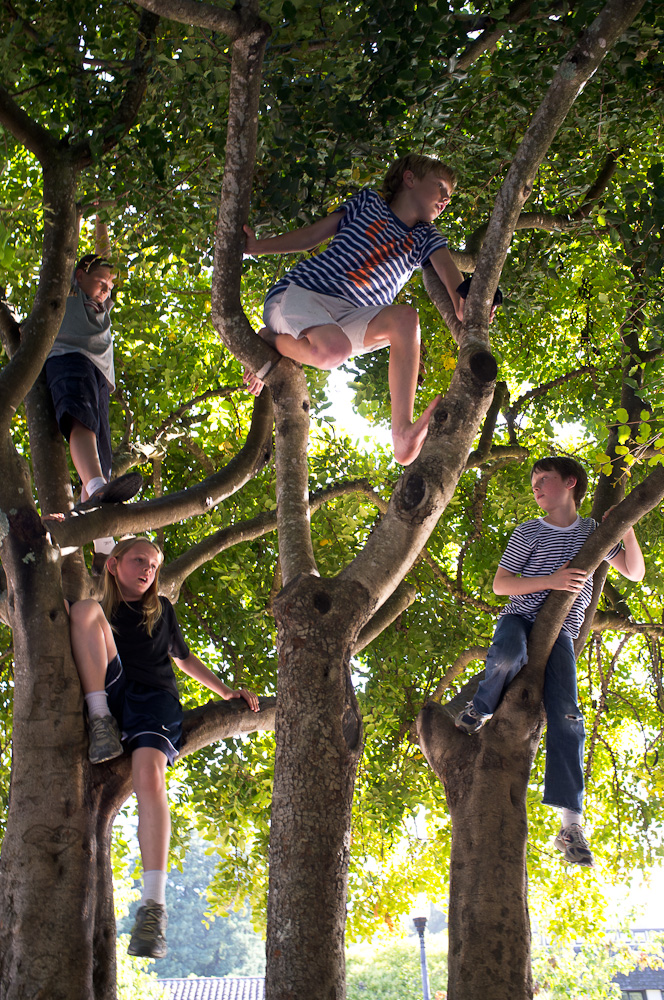 ISO 320, ƒ/4 at 1/60th.
ISO 320, ƒ/4 at 1/60th.
No, mine's not for sale.
Robert
Robert Plotkin is a former prosecutor who graduated from Columbia Journalism School. He has written for the New York Times, Miami Herald, San Francisco Chronicle and New York Observer, and is a former newspaper and magazine editor and publisher. He can be reached at [email protected].
The Fujifilm X100 is in stock at Amazon.com and at Amazon.uk
and at Amazon.uk
Send this post to a friend
Please help support TOP by patronizing our sponsors B&H Photo and Amazon
Note: Links in this post may be to our affiliates; sales through affiliate links may benefit this site. More...
Original contents copyright 2011 by Michael C. Johnston and/or the bylined author. All Rights Reserved.
Featured Comment by Mani Sitaraman: "It's quite simple. Fuji/Smuji. I want a Leica M10 instead. Until the M10 comes out. After that precise moment, I'll want a Leica M11. P.S.: Terrific review, by the way."
Featured Comment by Ted Zimmerman: "Well I've had mine for about a week and, having read seemingly endless complaints about the camera's idiosyncrasies and faults prior to purchase, I braced for a qualified shooting experience with it. Nothing could be further from the truth.
"The X100 is an absolute delight to use. Its design, size, and ergonomics are tailored to enhance the creative process. Sure, the AF could be faster (I had a GF1 kit so know that camera's strengths) but honestly, the positive attributes of this little gem far outweigh the occasional workarounds required to achieve focus.
"Amazingly, the image quality is on par with that of my D700. As the reviewer has rightly noted, tonal rendition (and transition) is superb. I can shoot uninhibited at ISO 3200 and still retain highlight detail. And the color! What a refreshing step up from the drab output of the Panasonic.
"Say what you like about 'retro' and 'old guys.' This camera delivers on enough fronts with a style and class unmatched by the competition. Fuji deserves accolades for bringing a risky product to market, and I haven't had this much fun shooting in years."
Featured Comment by Steve Rosenblum: "I owned an x100 for a month last spring and then sold it. It was tantalizingly close for me, but no cigar. I took it to the Turnley Paris Street Photography workshop, but found the autofocus delay and difficulties put me in the position of capturing the moment after the 'decisive moment' all the time.
"From a street shooting perspective it could easily be fixed with a firmware upgrade that would implement a straightforward hyperfocal distance or 'snap focus' mode such as is found on Ricoh cameras. It seems like that would be simple to implement, it is a single focal length lens. In that mode you would just choose the aperture and it would place the lens at its hyperfocal distance and you could blaze away without worrying about autofocus using the wonderful optical viewfinder just like we did by a quick twist of the lens barrel in the old days. It would be the perfect street shooter—small, discreet, quiet, quick, great lens and sensor—but, alas, nope!"
, and photography blogger Kirk Tuck's monthly column on TOP was planned to appear on the last Saturday of every month, but he was on deadline for his next book on lighting last Saturday. A week late is better than never, I think you'll agree.
